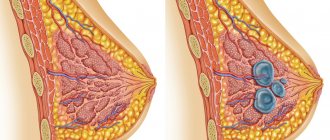The following processes occur in a woman’s body with the participation of luteinizing hormone::
- growth, maturation and rupture of the follicle;
- movement of the egg through the fallopian tube;
- transformation of the residual part of the follicle into the corpus luteum;
- formation of estrogen and progesterone.
For men, luteinizing hormone (LH) is important for:
- sperm development;
- the formation of testosterone and its penetration into the seminiferous tubules;
- sperm formation;
- synthesis of sex steroid binding globulin;
- maintaining a high level of sexual desire.
LH secretion is regulated by the hypothalamus (liberins and statins), as well as by sex hormones . With a lack of testosterone, estrogens, and progesterone, the release of LH increases according to the feedback principle. This is especially pronounced in elderly patients.
LH secretion is regulated by the hypothalamus and sex hormones
A blood test for LH levels can help assess the functioning of the hypothalamus, pituitary gland, and gonads. It is indicated during diagnosis :
- causes of infertility;
- early or late puberty;
- state of reproductive function (readiness for fertilization);
- when stimulating ovulation, determining the day for conception;
- menorrhagia (bleeding from the uterus) with an unknown cause;
- the beginning of menopause;
- disturbances in the cyclicity of menstruation;
- hyperandrogenism (excess testosterone) in women;
- polycystic ovary syndrome;
- hypothalamic form of amenorrhea (cessation of menstruation);
- luteal phase deficiency;
- low potency, sexual desire in men, decreased sperm count and limited sperm motility.
The analysis has maximum specificity for amenorrhea due to disorders of hypothalamic secretion and luteal insufficiency . In all other conditions its role is secondary. Patients are shown ultrasound and additional diagnostic methods.
Preparation for the test includes:
- break from eating for at least 10 hours before the examination;
- elimination of physical and emotional overload during the day;
- prohibition of smoking and drinking any drinks (except water) 3 hours before the test;
- discontinuation of hormonal drugs and a number of medications for 3-5 days (on the recommendation of a doctor);
- giving up alcohol for 2 days.
The day before the test, it is advisable to limit animal fats. For women, the period of the menstrual cycle is extremely important. Most often, gynecologists send for analysis on days 4-6, but when determining the date of ovulation, you need to donate blood daily from 8 to 18 . The result is usually ready within a day.
Before the onset of puberty, the concentration of the hormone is low.
| Age in years | LH in mIU/ml |
| up to 1 | less than 0.7 |
| 1-3 | 0,9-1,85 |
| 4-8 | 0,7-2,1 |
| 9-13 | 0,5-6,8 |
| 14-18 | 0,6-19 |
In women, after the menstrual cycle has established, fluctuations in LH levels (in mIU/ml) are determined by its phase:
- follicular and menstrual period (approximately 1-14 days) – 2.4-12.4;
- ovulation (13-15 days) – 15-96;
- luteal (15-27) – 1.2-11.4.
During pregnancy, LH decreases to 8-10 units , approximately the same indicators will be found in a woman if she takes hormonal contraceptives. A year after the last menstruation (in postmenopause), the hormone rises to 10-58 mIU/ml.
For a healthy man of the reproductive period, the norm is from 1.7 to 8, mIU/ml . After 60 years, its rate increases, which is explained by the fading of testosterone formation.
For children, increased levels are usually a sign of congenital pathology - adrenal hyperplasia, underdevelopment of the gonads, and developmental defects. Girls with changes in the synthesis of sex and gonadotropic hormones may have an enlarged clitoris and an underdeveloped vagina.
The reason for the increase in PH during puberty may be:
- autoimmune and infectious diseases;
- tumor lesions of the ovaries (benign and malignant), polycystic changes;
- surgery, radiation and chemotherapy of the gonads;
- decreased hormonal activity of the thyroid gland;
- renal failure;
- endometriosis;
- premature ovarian failure syndrome;
- meningoencephalitis spreading to the pituitary gland, hypothalamus;
- neoplasms of the pituitary-hypothalamic region.
A temporary increase is caused by the use of Parlodel, Proscar, Nizoral, Veroshpiron, Tamoxifen, as well as intense physical training, fasting, strict diets or a monotonous diet lacking vitamins, protein and mineral salts.
Drugs that cause a temporary increase in luteinizing hormone
Low LH levels are most often a consequence of dysfunction of the hypothalamus and pituitary gland . This can lead to:
- traumatic brain injury;
- neuroinfection;
- intense blood loss during childbirth with the development of acute oxygen starvation of the brain and pituitary insufficiency (Sheehan syndrome).
Luteinizing hormone deficiency is also caused by:
- excess prolactin in the blood;
- delayed sexual development;
- dwarfism;
- Prader-Willi syndrome;
- alcoholism;
- excess body weight;
- pregnancy;
- smoking;
- stress, surgery;
- polycystic ovary syndrome (atypical course);
- the use of drugs containing female and male sex hormones, anticonvulsants, hormonal contraceptive pills, anabolic steroids.
Read more in our article on luteinizing hormone.
Menstrual cycle
From the moment of puberty, every girl begins to experience regular changes in her body. They are represented by cyclical growth and rejection of the endometrium (the inner lining of the uterus), which occurs in the form of monthly bleeding. This process is divided into several phases:
- Follicular (1-14 days). It is characterized by the gradual growth of small sacs (follicles) with eggs inside. FSH plays the main role in this period. The normal value of luteinizing hormone in this phase is 1-13 mU/l.
- Ovulation (13-15 days). A very short phase, which is manifested by the rupture of the membrane of the sac with the release of the germ cell into the abdominal cavity of the woman. The normal amount of LH is 25-150 mU/l.
- Luteal (15-28 days). Characterized by the growth of the corpus luteum and the production of progesterone. Normal LH values in this phase are 2-18 mU/l.
Separately, it is worth mentioning about the fair sex during the period after menopause. At this age, the amount of luteotropin increases to 15-50 mU/l, which is considered normal.
In men, the levels of this biologically active compound remain stable throughout life. They can fluctuate between 1-10 mU/l. If there is a significant increase in the amount of luteinizing substance, then a problem has arisen that requires adequate therapy.
Sex hormones
In the body of both men and women, the pituitary gland synthesizes three sex hormones. They are responsible for sexual desire and the ability to conceive a child. These hormones are FSH, LH and prolactin. Luteinizing hormone in women increases during ovulation. It is at this moment that a woman is ready to conceive a child. This phase of the menstrual cycle is called luteal.
The level of sex hormones in a woman during the menstrual cycle
High LH: causes and treatment
The pituitary gland is one of the most important endocrine glands in men and women. It synthesizes most of the most popular biologically active substances, which are responsible for the normal functioning of the entire body. Luteinizing hormone (LH, luteotropin) is one of them.
It is one of the activators of internal organs, since it is responsible for the increased release of progesterone in women and testosterone in men. An increase in the amount of LH or a decrease in it can significantly affect a person’s sex life.
In most cases, if there is an excess or deficiency of this biologically active substance, adequate treatment of the disease may be necessary.
How is luteinizing hormone produced?
The LH hormone (what it is in women and what it is responsible for cannot be understood without basic knowledge of how it is produced) is a kind of “regulator” of the growing up of a young girl. It is the level of its content in the blood of a female person that determines the onset of menstrual cycles during adolescence, stimulating the active development of the main genital organs - the uterus and ovaries.
LH hormone. What is it like in women? It is produced in the pituitary gland and is responsible for a number of important functions in the body.
Responsible for the direct production of luteinizing hormone in a woman’s body is the pituitary gland, located at the base of the human brain. In adulthood, the hormone ensures the regularity and appropriate duration of menstrual cycles.
What are the dangers of deviations from the norm?
Deviations from the norm are fraught with infertility
LH regulates reproductive function, so hormone deficiency primarily provokes various pathologies, the main complication of which is infertility in women and men. Insufficient production of the hormone in the pubertal phase leads to a delay in the process of puberty, which can cause underdevelopment of sexual characteristics in adulthood, disorders of internal organs, infertility, the development of breast or ovarian cancer in women, and neoplasms in the testicles in men. Lack of the hormone affects the psychological and emotional state, attacks of irritation, apathy, and depression are observed.
Deviation from the norm in LH levels contributes to the development of hormonal imbalance, which can cause pathologies of various organs. The consequences of abnormal LH synthesis affect the ability to conceive; in women, the cyclicity of ovulation is disrupted; in men, the number of sperm in the ejaculate decreases.
An increase or decrease in hormone production is not an isolated pathology, but a consequence of the presence of diseases, so deviation from the norm without proper therapy is dangerous due to the development of factors that provoke a change in LH levels.
What is luteinizing hormone responsible for in the body?
The normal functioning of the gonads depends on this substance. In addition, it affects the production of female and male sex hormones - progesterone and testosterone, respectively. The pituitary gland produces lutropin in both women and men.
An increase in LH concentration in the blood indicates the onset of ovulation. In the female body, lutropin is produced in large quantities approximately 12-16 days after the start of menstruation. This phase of the cycle is also called the luteal phase in medicine.
In males, its production is always stable. Luteotropin in the male body increases the synthesis of testosterone, on which the full maturation of sperm depends.
It is worth noting that modern ovulation tests are based precisely on the principle of assessing luteotropins in urine. When it is elevated, it means that ovulation will begin soon or is already occurring. For women who want to get pregnant, this is the most favorable moment for conception.
When to get tested
A blood test for LH levels can help assess the functioning of the hypothalamus, pituitary gland, and gonads. It is indicated during diagnosis:
- causes of infertility;
- early or late puberty;
- state of reproductive function (readiness for fertilization); when stimulating ovulation, determining the day for conception;
- menorrhagia (bleeding from the uterus) with an unknown cause;
- the beginning of menopause;
- disturbances in the cyclicity of menstruation;
- hyperandrogenism (excess testosterone) in women;
- polycystic ovary syndrome;
- hypothalamic form of amenorrhea (cessation of menstruation);
- luteal phase deficiency;
- low potency, sexual desire in men, decreased sperm count and limited sperm motility.
The analysis has maximum specificity for amenorrhea due to disorders of hypothalamic secretion and luteal insufficiency. In all other conditions, its role is secondary, so it is usually necessary to simultaneously examine the levels of progesterone, testosterone, estradiol, as well as pituitary follitropin, prolactin. Patients are shown ultrasound and additional diagnostic methods.
The role of LH in menopause
During menopause, the LH hormone, like other components of a woman’s hormonal background, undergoes significant changes, which means its level is highly dependent on the age and condition of the human body.
Due to aging, the concentration of luteinizing hormone increases significantly, thereby suppressing the production of other hormones, in particular estradiol. It is the “off-scale” LH level in older women that indicates the onset of menopause, also known as menopause.
A significant increase in the level of the hormone in question is due to the inability of the aging body to use it for its intended purpose, as a result of which LH accumulates, manifested in an increase in hormonal concentration in vital systems, revealed by a special blood test.
Reasons why it is elevated in girls and women
For children, increased levels are usually a sign of congenital pathology - adrenal hyperplasia, underdevelopment of the gonads, and developmental defects. They can often be identified from birth. Girls with changes in the synthesis of sex and gonadotropic hormones may have an enlarged clitoris and an underdeveloped vagina, which sometimes requires clarification of gender by analysis of the chromosome set (karyotyping).
The reason for the increase in PH during puberty may be:
- autoimmune and infectious diseases;
- tumor lesions of the ovaries (benign and malignant), polycystic changes;
- surgery, radiation and chemotherapy of the gonads;
- decreased hormonal activity of the thyroid gland;
- renal failure;
- endometriosis;
- premature ovarian failure syndrome;
- meningoencephalitis spreading to the pituitary gland, hypothalamus;
- neoplasms of the pituitary-hypothalamic region.
A temporary increase is caused by the use of Parlodel, Proscar, Nizoral, Veroshpiron, Tamoxifen, as well as intense physical training, fasting, strict diets or a monotonous diet lacking vitamins, protein and mineral salts.
Reasons for increased LH in women
Normal LH concentrations in the first phase of the cycle indicate approaching ovulation. Its presence is an indispensable condition for fertilization to occur. But due to various factors in a woman’s body, the volume of this biologically active substance increases.
The following reasons for increased concentrations of luteinizing hormone are identified:
- Polycystic ovary syndrome. The disease is characterized by the formation of multiple cysts inside the paired female organ. The pathology causes increased production of testosterone, which inhibits the synthesis of luteinizing hormone.
- Tumor process in the pituitary gland. Pathology leads to failure of this part of the brain. The result is a decrease in the production of prolactin, somatotropin, corticotropin, thyrotropin.
- Physiological decline of ovarian function (decrease in LH occurs during menopause).
- Inflammatory diseases of the reproductive system (adnexitis, endometritis).
- Renal failure, neoplasms. Leads to damage to the adrenal cortex, a decrease in the production and concentration of corticosteroids.
The hormonal balance of women is adversely affected by nervous tension, heavy physical labor, lack of sleep, and adherence to a strict diet. Predisposing factors are a history of abortion, decreased immune properties of the body, hypovitaminosis, and previous surgical interventions on the ovaries.
Surgical treatment to reduce LH levels in the blood of women
When a tumor process is detected in the pituitary-hypothalamic system, the issue of stopping it is considered. Not in all clinical cases it is possible to eliminate the neoplasm using medication. If the only possible option for normalizing PH is surgery, the patient should prepare not only for the upcoming intervention, but also for hormonal therapy. It is certainly carried out to stabilize the balance in the body.
Additionally, the course introduces drugs whose action is aimed at normalizing blood circulation inside the brain tissue. Actovegin, Glycine, Cerebrolysin are used.
Symptoms of increased LH in women
Immediately after an increase in the concentration of LH in the body, a woman observes the following symptoms:
- Menstrual irregularities. Lack of ovulation is a consequence of egg immaturity. The reason is the filling of their follicles with secretion and subsequent degeneration into cystic neoplasms.
- Regular delays in menstruation not associated with pregnancy.
- Frequently repeated involuntary abortions. More than 2 miscarriages in a row are a consequence of hormonal imbalance.
- Pain in the lower abdomen, pulling sensations in the lumbosacral back.
- The appearance of additional uterine bleeding, in addition to menstruation.
- Irritability, spontaneous mood swings, depressed state. The listed phenomena more often occur when LH increases against the background of a pituitary tumor. The reason is a disruption in the production of endorphins due to damage to a part of the brain.
- Weight gain - because the fat-burning hormone lipotropin is not fully produced by the brain.
- Skin damage by UV rays, predisposition to burns due to deficiency of MLH (melanocyte-stimulating hormone).
- Premature or delayed onset of puberty. In childhood, growth retardation is noticeable.
- Hirsutism. The appearance of hair on areas of the body that are uncharacteristic for women.
We recommend reading: Adrenaline: what it is, functions of the hormone, benefits and harms
Even one of the listed signs is enough to visit a gynecologist, undergo diagnostics and, possibly, treatment.
But the main reason for contacting a specialist is a problem with pregnancy. Despite having sexual activity without using contraceptives, due to the high concentration of LH, the likelihood of conception is excluded.
Indications for the study
Medical specialists recommend monitoring luteinizing hormone by taking appropriate tests at least once every six months. However, there are emergency cases that require immediate research as soon as possible.
Such situations traditionally include:
- irregular menstrual cycles or their complete absence for several months;
- suspicions on the part of doctors for a number of medical indications for infertility of various types, premature menopause or amenorrhea;
- frequently recurring cases of miscarriage due to miscarriages at various stages;
- premature or, conversely, delayed maturation of the female reproductive system, diagnosed by qualified specialists based on a number of relevant indicators;
- frequent bleeding of unknown origin, including uterine (usually indicate the presence of malignant or benign tumors);
- the need to track ovulation for conception or check the female body for the presence of anovulatory cycles, prescribed when a married couple is planning a pregnancy;
- a significant decrease in sexual desire for a sexual partner;
- examination of a woman before undergoing artificial insemination (in vitro fertilization, also known as IVF);
- monitoring the dynamics of changes after various types of hormonal therapy;
- Excessive hair growth on a girl’s body, concentrated mostly in the face area.
Diagnostics
Diagnosis includes laboratory testing, ultrasound and MRI. During these types of examinations, the LH level is determined and the condition of the reproductive system organs is assessed. The concentration of luteinizing hormone must be determined at the initial stage of diagnosis. Since the clinical manifestations of the condition, when it is below the norm or exceeds it, are identical.
To assess the functional capacity of the pituitary gland, a study of its hormones is carried out in the follicular phase. The reason is the peculiarities of the concentration of substances in different periods of the cycle. In the luteal phase, pituitary hormones are significantly increased, and the test response will be incorrect.
How to take a blood test for the LH hormone
There are rules for taking blood to determine hormonal levels, if violated, the concentration of the substance will not be true. This will lead to the doctor misinterpreting the results and making an incorrect diagnosis. Therefore, before taking a blood test for LH, ask your doctor how to donate blood for luteinizing hormone and when it needs to be taken.
- Active sports activities are excluded before testing.
- No special diet is required, but doctors advise not to eat fatty foods 2-3 days before the test.
- In the morning before blood sampling, do not eat or smoke. Some foods cause slight changes in hormonal status.
- Before taking blood to test for the LH hormone, the patient is given a form on which information about the day of the menstrual cycle, the presence or absence of pregnancy and the onset of menopause is entered.
- Blood for luteinizing hormone must be donated from a vein on the 5th day of the cycle . It is placed inside a sterile tube and examined on a semi-automatic analyzer. This technique reduces the risk of medical error. The results are given to the patient the next day.
Important! Blood for LH is donated together with FSH, since these hormones are interrelated in women. Follicle-stimulating hormone is also responsible for reproductive function.
Preparing for the test
General recommendations for passing the test include:
- break from eating for at least 10 hours before the examination;
- elimination of physical and emotional overload during the day;
- prohibition of smoking and drinking any drinks (except water) 3 hours before the test;
- discontinuation of hormonal drugs and a number of medications 3-5 days in advance (at the discretion of the attending physician)
- giving up alcohol for 2 days.
You should not make drastic changes to your diet, but the day before the test it is advisable to limit animal fats. For women, the period of the menstrual cycle is extremely important. Most often, gynecologists send for analysis on days 4-6, but when determining the date of ovulation, you need to donate blood daily from 8 to 18. The result is usually ready within a day.
Norms of luteinizing hormone in the body in women
In males, after puberty, LH production does not change. However, in women, norms fluctuate throughout the entire cycle.
When the body secretes it in sufficient quantities, the norms will be as follows:
- 1 – 12 days of the cycle – 2-14 mU/l;
- From 12 to 16 – 24-150;
- From the 16th day until the start of the next menstruation – 2-17.
It is worth noting that a woman, when taking tests, should know that the normal level of luteinizing hormone varies not only in certain phases of the cycle, age also matters, for example, in newborn children it is about 0.7, in girls 5 years old - up to 0.9 , in 16-year-old adolescents – 0.6-21, and in women after menopause – 14.2-52.3 mU/l.
The above data is approximate. They vary depending on the individual characteristics of the organism. So if the test results showed an increase in LH levels, then only a doctor can correctly decipher them.
LH tests are prescribed for:
- Lack of menstruation;
- Short and scanty periods (lasting less than 3 days);
- Infertility;
- Miscarriage;
- Stunted growth;
- Uterine bleeding;
- Endometriosis;
- Delayed or premature sexual development;
- Decreased sexual desire;
- Determining the period of ovulation;
- Monitoring the effectiveness of hormone therapy;
- Research after in vitro fertilization (IVF);
- Polycystic ovary syndrome;
- Hirsutism is excessive hair growth in women on the chest, back, abdomen, and chin.
In men, tests for luteinizing hormone, the norm of which ranges from 0.5 to 10 mU/l, can be taken any day.
To get a reliable result, blood must be taken for analysis between the 3rd and 8th day of the cycle or between the 19th and 21st. Blood sampling must take place on an empty stomach.
Correction of deviations from the norm.
The correction method depends on the cause of the failure
To correct LH levels, it is necessary to find out the cause of the deviations. If changes in hormone concentrations are caused by the use of steroid drugs, in some cases it will be enough to stop taking them to optimize LH production; recovery usually takes 5 weeks.
For a number of pathologies, a necessary element of correction is hormone replacement therapy, the purpose of which is to restore normal hormonal levels. Hormone-based drugs are used for premature puberty or delayed sexual development, Sheehan syndrome, premature ovarian failure, Swyer syndrome, endometriosis, hypogonadotropic hypogonadism, Shereshevsky-Turner syndrome.
If the cause of changes in LH synthesis is testicular atrophy, therapy may include surgery to bring the testicles into the scrotum, Ivanissevich surgery, and in some cases, orchiectomy.
In the presence of tumors, radiation and chemotherapy or surgery are used.
Source of the article: https://gidanaliz.ru/analiz/gormon/lg-povyshen.html
Deviations in the first phase
An increased level in the first phase indicates the presence of serious deviations in the functioning of the reproductive system. Exceeding the norm is a common cause of infertility.
Important! There is a direct connection between LH and estrogens in a woman’s body. The higher the LH level in the first phase, the higher the estrogen. The result of this interaction is the onset of ovulation.
In case of dysfunction, an increase in the level of LH does not entail an increase in the content of estrogen in the blood, as a result, the maturation of the egg and the formation of the corpus luteum do not occur. The cycle is disrupted, as a result of which the immature follicle turns into a cyst.
Possible deviations and their causes
The physiological increase in luteinizing hormone to maximum values is the day before ovulation. If this happens on other days, this is a variant of the pathological condition. Fluctuations of these substances in the body significantly change the health status of a woman. Amenorrhea (lack of menstruation) and infertility may occur. Therefore, if the concentration of any hormone shows a change in the norm, consult a doctor. He will explain what causes this change in LH levels in women.
Increased concentrations of luteinizing hormone in women
A pathological and physiological increase in the indicator is observed in the following cases:
- the formation of many cysts on the ovaries;
- lack of ovarian function before menopause;
- renal failure;
- development of a tumor (malignant or benign) in the pituitary gland;
- inflammation of the endometrium of the uterus (endometriosis);
- insufficient functioning of the glands that secrete sex hormones;
- long fasting or exhausting diets;
- severe stress;
- active daily sports.
We recommend reading: Male menopause syndrome: signs of menopause, methods of treatment and prevention of male menopause
Decrease in LH levels in women
A decrease in LH levels in women below normal is a pathological condition that also requires treatment. The reasons causing a decrease in luteinizing hormone are:
- underdevelopment of the genital organs;
- delayed sexual development;
- lack of luteal phase;
- increase in the amount of adipose tissue;
- bad habits (smoking, alcohol abuse);
- drug use;
- operations affecting the area of the ovaries or pituitary gland;
- amenorrhea (absence of rejection of the uterine mucosa and monthly bleeding);
- formation of cysts on the ovaries;
- stress;
- underdevelopment or decreased function of the pituitary gland;
- slow growth or dwarfism;
- disruption of the release of other hormones (a decrease in LH is observed with an increase in prolactin, which is normally intensely secreted during breastfeeding);
- the state of a woman's pregnancy.
After pregnancy, the concentration of LH in the blood decreases, and other hormonal substances of the reproductive system increase. The same condition occurs during breastfeeding. LH concentrations in the female body return to normal after the baby is weaned from the mother's breast.
Important! A woman's fertility level (her ability to become pregnant) is indicated by the ratio of LH and FSH (follicle-stimulating hormone). The number should be between 1.3 and 2.2. If the ratio of LH to FSH is less than one, fertility decreases.
Luteinizing hormone (LH) is elevated: causes, diagnosis
An important function of LH is participation in the ovulatory cycle.
Luteinizing hormone (LH) regulates the ovulatory cycle in women and promotes testosterone production in men. The concentration varies significantly depending on the stage of the menstrual cycle (MC); in the male body, the level of LH is within constant limits.
A physiological increase in LH in women occurs as the follicle matures; at the stage of egg release, an increase in the hormone level is observed by 6-10 times; the cyclical change in LH concentration persists until the onset of menopause. During postmenopause, hormone synthesis is at a high level. In men, LH production increases after 60-65 years.
Pathological growth of the hormone is caused by the following factors:
- Swyer's syndrome;
- pituitary adenoma;
- Stein-Leventhal syndrome;
- ovarian wasting syndrome;
- excessive physical activity;
- Shereshevsky-Turner syndrome;
- endometriosis;
- neoplasms in the testicles;
- syndrome of premature sexual development;
- taking medications: bromocriptine, clomiphene, spironolactone, trileptal, ketoconazole.
Symptoms and signs of elevated LH levels
One of the signs of high LH is miscarriage
Symptoms in women:
- pelvic pain is constant or before the onset of menstruation;
- oligomenorrhea and amenorrhea;
- uterine bleeding between menstrual cycles;
- dyspareunia (pain during or after sexual intercourse);
- oligoovulation;
- headache;
- irritability, tearfulness, weakness;
- decreased libido;
- miscarriage;
- hirsutism, masculinization;
- signs of menopausal syndrome (rapid heartbeat, changes in blood pressure, hot flashes).
For men:
- hardening, enlargement of the testicle;
- pain in the lower abdomen and scrotum;
- decreased sex drive;
- feminization.
Causes of decreased LH levels
Medicines can affect LH levels
LH is at low levels in men and women at an early age; with the onset of puberty, hormone production normally increases.
A reduced concentration is observed in the following pathologies:
- hypogonadotropic hypogonadism;
- Kallmann syndrome;
- anorexia nervosa;
- severe stress;
- luteal phase deficiency;
- testicular atrophy;
- delayed sexual development;
- Sheehan's syndrome;
- Marfan disease;
- taking anabolic steroids, conjugated estrogens, oral contraceptives, anticonvulsants.
Symptoms and signs of decreased LH levels
Fluctuations in body weight may be associated with LH levels
Among women:
- violation of the MC;
- hair loss, brittle nails;
- swelling;
- sudden weight gain or loss;
- depression;
- feeling of chronic fatigue;
- spontaneous miscarriages;
- violation of the cyclicity of ovulation or absence of ovulation;
- infertility.
Changes in LH levels affect the male reproductive system
For men:
- reduction in the size of the scrotum and testicle;
- disturbance of spermatogenesis;
- weight gain;
- decreased libido and potency.
In hereditary diseases (Marfan's disease), visual impairment, spinal deformity, and congenital contractures of the fingers and elbows are observed.
Sheehan syndrome occurs as a result of complicated childbirth, in which hypoxia of the pituitary gland occurs. There is a violation of lactation, unexplained weight gain, increased sensitivity to cold, drowsiness, memory impairment, oligomenorrhea.
Indications and preparation for the study
Finding the cause of male infertility is a reason for analysis
Analysis is prescribed in the following situations:
- establishing the causes of male and female infertility;
- assessment of reproductive function;
- determination of the ovulation phase;
- assessment of hormonal status;
- decreased libido and potency;
- spontaneous termination of pregnancy;
- premature development of secondary sexual characteristics;
- delayed puberty;
- masculinization in women (deepening of the voice, increased growth of body hair, acne);
- feminization in men (distribution of subcutaneous fat according to the female type, loss of body hair, decreased libido);
- MC disorders, manifested in rare or scanty menstruation, lack of cyclicity, increased bleeding;
- suspicion of polycystic ovary syndrome.
Physical activity should be limited on the eve of the test
Preparing to take the test.
- The test is taken on an empty stomach, food intake is completed 8-10 before the procedure.
- Increased physical activity is limited 72 hours before the test.
- Taking hormonal drugs is stopped 48 hours before.
- Alcoholic drinks and fatty foods are excluded one day before the test, smoking - 3 hours.
- Women are recommended to undergo the study on the 6-7th day of the MC, unless a different time is prescribed by the doctor.
- The period of the most favorable conception is determined using analysis daily, starting from the 7th day of the MC to the 20th day.
What are the dangers of deviations from the norm?
Deviations from the norm are fraught with infertility
LH regulates reproductive function, so hormone deficiency primarily provokes various pathologies, the main complication of which is infertility in women and men.
Insufficient production of the hormone in the pubertal phase leads to a delay in the process of puberty, which can cause underdevelopment of sexual characteristics in adulthood, disorders of internal organs, infertility, the development of breast or ovarian cancer in women, and neoplasms in the testicles in men.
Lack of the hormone affects the psychological and emotional state, attacks of irritation, apathy, and depression are observed.
Deviation from the norm in LH levels contributes to the development of hormonal imbalance, which can cause pathologies of various organs.
The consequences of abnormal LH synthesis affect the ability to conceive; in women, the cyclicity of ovulation is disrupted; in men, the number of sperm in the ejaculate decreases.
When the hormone level is high at an early age, the rate of growth and skeletal maturation is disrupted.
An increase or decrease in hormone production is not an isolated pathology, but a consequence of the presence of diseases, so deviation from the norm without proper therapy is dangerous due to the development of factors that provoke a change in LH levels.
Correction of deviations from the norm
The correction method depends on the cause of the failure
To correct LH levels, it is necessary to find out the cause of the deviations. If changes in hormone concentrations are caused by the use of steroid drugs, in some cases it will be enough to stop taking them to optimize LH production; recovery usually takes 5 weeks.
For a number of pathologies, a necessary element of correction is hormone replacement therapy, the purpose of which is to restore normal hormonal levels.
Hormone-based drugs are used for premature puberty or delayed sexual development, Sheehan syndrome, premature ovarian failure, Swyer syndrome, endometriosis, hypogonadotropic hypogonadism, Shereshevsky-Turner syndrome.
If the cause of changes in LH synthesis is testicular atrophy, therapy may include surgery to bring the testicles into the scrotum, Ivanissevich surgery, and in some cases, orchiectomy.
In the presence of tumors, radiation and chemotherapy or surgery are used.
For prevention, indirect factors of PH deviation should be excluded - smoking and alcohol abuse, and protect yourself from stressful situations. Women are advised not to overload the body with physical exercise beyond normal limits, and men are advised not to take anabolic steroids.
Source: https://gidanaliz.ru/analiz/gormon/lg-povyshen.html
What does elevated LH in the follicular phase mean?
Elevated LH levels with normal FSH levels indicate that serious systemic endocrine changes are occurring in the body. Since pregnancy is impossible in principle without a normal amount of LH, it is the excess of this hormone that is a common cause of hormonal infertility.
When this hormone is produced, ovarian receptors sense signals that it is time to start producing estrogens. There is a direct relationship between them and LH: in the follicular phase, the higher the LH, the higher the estrogen, and, conversely, with an increase in estrogen levels, LH also increases. As a result, it is this relationship that leads to the peak of luteinizing hormone and the onset of ovulation.
If the functions of the ovaries are impaired and there is no increase in the amount of estrogen in response to the production of LH, then ovulation and pregnancy are impossible, the egg does not mature to the end, and the corpus luteum is not formed. As a result, the normal course of the cycle is disrupted, and the remaining egg inside the ovary turns into a cyst. With systemic endocrine diseases such as polycystic disease, the functions of the ovaries are impaired and the follicles simply do not mature, remaining inside.
Elevated LH is a characteristic sign of diseases such as:
- Endometriosis;
- Polycystic disease;
- Kidney failure;
- Ovarian dysfunction.
What does it mean?
Luteinizing hormone is usually given on days 5-7 of the cycle.
If the results of laboratory tests reveal an increased content, we can speak with great confidence about previous ovulation. Usually on days like these, ovulation is expected within a few days. The highest concentration will be on the day of ovulation itself.
If a patient is diagnosed with infertility, the question is raised about the absence of ovulation. In this case, a hormone test is prescribed to confirm the diagnosis.
In addition to infertility, the question of increased hormone levels is also raised in cases of frequent miscarriages, sexual dysfunction, menstrual irregularities and other obvious problems with the patient’s sexual function.
What to do if LH is elevated in the follicular phase
An increase in the amount of LH in the follicular phase of the cycle is not a cause of health problems, but only a marker that allows diagnosing endocrine pathologies. The reason for the increase in its concentration is disturbances in the functioning of the ovaries, which are not able, in response to the production of LH, to begin producing the hormone needed in this case.
If the analysis shows an increase in LH, it is necessary for the doctor to order additional tests. They should include dynamic observation for several cycles in a row, excluding pathologies such as renal failure, malignant neoplasms, and disorders of the pituitary gland. Naturally, during the period of diagnosis and treatment, it is necessary to exclude such harmful factors as stress and toxins.
Elevated LH levels
Deviations in the concentration of luteinizing hormone are not always reflected in a decrease in its level. An equally significant reason for consultation with a medical specialist is a significant increase in its content in the blood of the woman being examined, provoked by a number of reasons.
The most common of them traditionally include:
- exhaustion of the nervous system due to frequent stress and constant psychological tension in a woman’s everyday life;
- general weakness or wear and tear of the body due to excessive physical exertion (usually due to visiting the gym and training there according to an incorrectly designed training program);
- frequent use of a certain number of medications that provoke hormonal imbalance;
- deviations from the normal functioning of the pituitary gland and hypothalamus, most often observed after the woman being examined has suffered injuries, bruises, or surgical interventions;
- dysfunction of the gonads, requiring additional examination to determine the causes of dysfunction of this kind;
- pathological changes in the functioning of the kidneys and adrenal glands;
- diagnosing premature dysfunction of the reproductive organs in the female body;
- a sharp significant decrease in the body weight of the woman being examined, both as a result of the disease and the usual diet for weight loss;
- the initial stage of the development of endometriosis, which can not only provoke hormonal imbalance, but also cause significant damage to women’s health in general;
- neoplasms of various types in one of the lobes of the pituitary gland, most often the anterior one.
Causes of low LH levels
Considering the high degree of importance of LH for the female body at any age, it is necessary to clearly understand the consequences of the deviations expressed in the reduced content of the hormone in question in the blood.
The main ones include:
- presence of excessive excess weight, obesity;
- insufficiency of the second phase of the menstrual cycle;
- prolonged smoking or drinking alcohol;
- taking medications that are difficult for the body and require restoration of defenses;
- recent surgical interventions;
- prolonged absence of menstruation in women at an age when menstruation should be regular;
- multifollicular ovaries or their advanced form - polycystic disease;
- frequent stress in the daily life of the subject;
- delayed physical or mental development as a result of genetic diseases;
- significant deviations in the normal functioning of the pituitary gland and hypothalamus, responsible for the production of luteinizing hormone;
- excessive production of prolactin, suppressing the increase in LH levels;
- pregnancy period;
- irregular menstrual cycle in women of childbearing age.
Causes
In women, a high level of the hormone in the blood indicates the beginning of the ovulation period.
This usually happens on the 12-16th day of the cycle (the cycle is calculated from the first day of menstruation). Directly on the day of ovulation, the content is highest and can be ten times higher than the standard norm. In other cases, an increase may indicate the following deviations:
- Polycystic ovary syndrome. It occurs when the balance of sex hormones in the body is disturbed. In this case, testosterone begins to be produced in increased quantities, the egg does not mature and ovulation does not occur. This condition leads to the formation of cysts from fluid-filled follicles. Often in such cases, women complain of a prolonged absence of menstruation, heavy bleeding, and pain in the lower abdomen.
- Pituitary tumor. The presence of benign or malignant formations in the pituitary gland leads to disruption of the functions of the entire organism.
- Kidney failure. Impaired kidney function makes it impossible for them to perform their main function – removing toxic substances from the body. As a result, the body is poisoned by decay products and the onset of various complications.
- Hunger, stress, physical activity. With the negative influence of external factors on the general condition of the body, increased production of the hormone occurs to maintain the normal functioning of the body.
- Endometriosis. A gynecological disease common among women of childbearing age, caused by the growth of the endometrium outside the uterus. In this case, unpleasant sensations in the lower abdomen, bloody intermenstrual bleeding, and discomfort during sexual intercourse are observed. The problem is eliminated by prescribing hormones that have a significant effect on endometrial cells.
Adjusting LH levels
The LH hormone (what it is in women needs to be found out for the prevention of various pathologies) has a certain level, which is important to correctly adjust if a deviation from generally accepted norms in medicine is detected.
Depending on the circumstances, an increase or decrease in luteinizing hormone is carried out through surgery or taking special hormonal medications prescribed by a qualified doctor: a gynecologist, endocrinologist, therapist or reproductive specialist.
If it is necessary to provoke conception after a period of hormone therapy, women being examined are traditionally prescribed combined oral contraceptives, which allow the reproductive system to rest, taking care of the production of the appropriate amount of hormones.
Falling into a “shock” state after abruptly stopping COCs, in most cases the ovaries restore their functions, and normalization of the LH level in the blood occurs automatically.
It is important to understand in this case the need to construct a regimen for taking hormonal drugs exclusively at an appointment with a specialist who knows the characteristics of the body of the woman being examined, and not by making an independent decision.
We recommend reading: Human hormones: their list, functions, effects on the body - table
Otherwise, you may not only fail to normalize the level of luteinizing hormone, but also provoke disturbances in the production of a number of other hormones, for example, prolactin.
In the absence of positive dynamics after taking oral contraceptives by qualified specialists, in most cases, in the absence of contraindications due to the patient’s health, it is proposed to resort to surgical intervention, which is a kind of artificial stimulation of ovulation.
One of the most common operations of this kind is laparoscopy. This type of medical manipulation involves cutting the outer layer of the ovaries in order to facilitate the further release of an egg ready for fertilization.
After restoring the normal functioning of the reproductive organs, in accordance with the constitution of the body and the physiological characteristics of the body, the concentration of luteinizing hormone should be restored.
In some cases, in particular with the timely diagnosis of tumors or other dysfunctions of the kidneys and adrenal glands, to correct LH levels, medical specialists prescribe complex treatment, including not only surgery, but also subsequent hormonal therapy with serious drugs.
In the vast majority of cases, hormonal treatment to restore the proper level of LH is carried out using medications containing progesterone, estrogen, androgen, as well as luteinizing hormone itself (Pergonal, Luteotropin, and so on).
In the absence of serious indications for drug treatment or surgery, it is advisable for a woman to try to adjust the LH concentration using traditional methods.
These include daily oral use:
- natural apple juice;
- pomegranate juice;
- freshly squeezed citrus juice;
- linseed oil;
- herbal infusions, including mint, linden, hops or cones;
- berry liqueurs from raspberries, strawberries, wild strawberries and so on.
Based on the above facts, which prove the high degree of importance of monitoring the LH hormone in women, as well as explaining what it is and how deviations from generally accepted norms can be diagnosed, we can conclude that it is necessary to regularly donate blood for hormonal testing in order to avoid the development of serious diseases.
Increasing LH levels in women with Pergonal
Pergonal is a drug containing human gonadotropin. The action of the hormonal agent is aimed at increasing estrogen levels, increasing the thickness and volume of the endometrium. The medicine creates favorable conditions for pregnancy.
The drug allows you to increase LH by stimulating the structural elements of the ovaries, synchronized with the activity of the anterior pituitary gland. Pergonal is not prescribed if the patient is highly predisposed to the formation of cysts not associated with PCOS (polycystic ovary syndrome). Other contraindications – tumor process of the mammary glands, uterus, appendages; the presence of malformations of the genital organs. Pergonal is not prescribed for vaginal bleeding until the cause of its development has been established.
Side effects:
- Pain in the epigastric region.
- Increased sensitivity of the mammary glands.
- Slight enlargement of the ovaries, causing pain in the lower abdomen.
- Weight gain of at least 10% of the initial weight (what it was at the time of starting treatment with the drug).
- Joint pain, body aches.
- Accumulation of intestinal gases, stool upset, bloating.
Other possible complications: disturbance of electrolyte metabolism; vein thrombosis; slight increase in body temperature, accompanied by chills.
The drug increases the likelihood of ectopic pregnancy. If any of the listed conditions occur, you should immediately stop using the product and notify the observing gynecologist.
Increasing LH levels in women with Luveris
The active substance is lutropin-alpha. The drug provides several types of action - luteinizing, estrogenic, follicle-stimulating. The dosage and frequency of use are prescribed only by the observing gynecologist.
Contraindications:
- endocrine disorders (especially dysfunction of the thyroid gland, adrenal cortex);
- polycystic ovary syndrome;
- the presence of tumors of the pituitary gland, hypothalamus;
- benign tumor of the uterus;
- uterine bleeding of unknown etiology;
- allergy to lutropin-alpha or phosphoric acid;
- cancer of the ovaries, uterus, breast (these tumors are estrogen-dependent).
The drug is characterized by several side effects that can cause irreparable harm to the patient’s health. These complications include vein thrombosis and the formation of multiple cysts inside the ovaries.
Common side effects are abdominal pain, breast tenderness, and swelling. Dyspeptic disorders (nausea, vomiting) often occur. If at the time of starting Luveris administration the patient had a history of primary damage to the fallopian tubes, the risk of ectopic pregnancy increases.
Luteinizing hormone is elevated, consequences and methods of reduction
Luteinizing (yellow) hormone is one of the biologically active substances of the genital area synthesized by the anterior lobe of the pituitary gland. Then from the pituitary gland it enters the bloodstream. For the normal functioning of the body, its quantity must correspond to the norms. If luteinizing hormone (LH) is increased or decreased, the stability of the gonads is disrupted.
In its chemical structure, it is similar to follicle-stimulating secretion and is a complex hormone consisting of glutamic acids. LH hormone is a glycoprotein whose molecular weight exceeds 30 kDa. To maintain its normal level, a certain frequency of GnrH stimulation is required. When discrepancies occur, the amount of circulating gonadotropins decreases.
The role of the hormone
The primary role of the hormone is to normalize the functioning of the reproductive system.
It is responsible for the manifestation of the first sexual characteristics and a person’s ability to conceive. Steroid sex hormones have a direct effect on the vulnerability of the pituitary gland to the stimulating influence of GnrH.
The purpose of luteinizing hormone is to ensure stable functioning of the gonads and the production of female and male sex hormones - progesterone and testosterone.
It stimulates the production of estrogen by a woman’s ovaries and regulates the activity of granulocytes; in addition, it affects the growth of egg follicles and causes differentiation of cells of the granular layer.
If luteinizing hormone is elevated during the follicular phase, then this is normal.
The level of LH concentration at the end of the follicular period contributes to the formation of an egg ready for fertilization and affects a woman’s libido.
In men, luteotropin stimulates Leydig cells, which produce testosterone, which is necessary for the correct and timely maturation of sperm.
When the concentration of LH does not exceed the standards, pregnancy proceeds without complications, there is protection against possible miscarriages and conditions are created for the normal development of the fetus.
When is luteinizing hormone elevated in a woman? Main reasons
A change in the amount of gonadotropic substance can be caused by natural physiological reasons, depending on the phases of the menstrual cycle. In the early follicular phase it is at a reduced level and increases gradually towards the day of ovulation. Subsequently, its increase occurs with the beginning of the menstrual cycle and reaches a peak during ovulation.
Luteinizing hormone levels depend on gender and age. In women, its concentration also varies depending on the menstrual cycle and the duration of pregnancy.
Norms for LH concentration in human blood depending on gender and age:
- for women during the luteal phase: 3-16 mU/l;
- for women during the follicular stage: 1-13 mU/l;
- for females during the period of ovulation: 25-148 mU/l;
- for girls from birth to 7 years: up to 1 mU/l;
- for women during menopause: 15-33 mU/l;
- for men constantly throughout life: 1-14 mU/l.
If luteinizing hormone is elevated in men, then its high level may indicate the following problems:
- insufficient functionality of the gonads;
- orchitis;
- alcoholism;
- tumor in the area of the pituitary gland;
- renal failure.
Elevated hormones in men can be observed after 60 years of age; as a rule, this is based on some disease. In addition, an increase in the level of gonadotropin causes aging of the body, which leads to a gradual decline in the function of the gonads.
Excess peptide hormone may result from:
- prolonged amenorrhea;
- disruption of the pituitary gland due to damage;
- infertility;
- ovarian exhaustion;
- scanty menstruation;
- renal failure;
- excessive sports training;
- growth disorders;
- fasting;
- insufficient functionality of the gonads;
- stress;
- not bearing a fetus;
- delayed sexual development;
- dysfunctional bleeding from the uterus;
- premature onset of puberty;
- endometriosis;
- decreased libido;
- polycystic ovary syndrome;
- excessive use of certain medications;
- exposure to x-ray radiation;
- increased growth of body hair in women, according to the male type.
To determine the cause, one blood test is not enough; the doctor must conduct additional research and make a diagnosis based on the information collected.
What does an excess of hormones lead to?
Glycoprotein hormones play a fundamental role in the functioning of the body and any deviation from the norm can lead to serious complications.
Excess LH in childhood can cause premature puberty of pituitary or central origin.
During reproductive age, its increase is often recorded in patients with polycystic disease, insufficient ovarian function, aminorrhea and pituitary gland dysfunction.
Increased levels of luteinizing hormone lead to the following consequences:
- irregular menstrual cycle;
- pathological weight loss;
- polycystic ovary syndrome;
- inability to get pregnant;
- early ovarian dysfunction;
- Iron-deficiency anemia;
- endometrioma;
- risk of miscarriage;
- gland dysfunction;
- pathologies of the kidneys and other organs.
In men, high levels of the substance cause sexual dysfunction.
To obtain reliable information about the level of the substance in the blood, the test must be taken on an empty stomach and only in the morning. Women only need to donate blood on the 8th or 21st day of their menstrual cycle.
On the eve of the test, you should avoid drinking alcohol and excessive physical activity.
How to reduce in men
Most often, the problem situation lies in the work of the pituitary gland, which actively produces luteinizing hormone. Correction is made using hormone therapy.
Depending on the disease and characteristics of the body, various hormones are prescribed:
- progesterones;
- androgens;
- estrogens.
Treatment with ergot preparations is effective:
- Bromocriptine.
- Cabergoline.
Taking hormonal drugs entails side effects, so estrogen-gestagen drugs are prescribed to prevent the growth of the endometrium. To check the effectiveness of treatment, an ultrasound and blood test are performed.
How to reduce in women
Treatment of elevated luteinizing hormone includes a comprehensive examination. To restore reproductive function, during the IVF protocol and with polycystic ovary syndrome, hormonal medications may be required.
Also, to reduce LH, the following are prescribed:
- estrogen;
- androgen;
- progesterone.
These substances normalize the function of the reproductive system and have a positive effect on metabolism. The dosage and type of drug should be prescribed by a doctor.
For polycystic ovary syndrome, oral contraceptives with androgenic action are prescribed. You should start taking the drug at a certain time in the cycle, and continue taking it for 3 months, after which you should take a break.
In some cases, surgery may be required. This applies to pituitary tumors, cryptorchidism and polycystic ovary syndrome. In this case, surgical treatment is combined with medication.
For endometriosis, to reduce the yellow hormone in the body, a long course of hormone therapy is prescribed, which can last up to six months. This picture is often observed when the condition returns to normal while taking medications, but then the hormonal imbalance resumes.
This condition is possible due to a disruption of one’s own hormonal levels due to disruption of the pituitary gland.
In order to normalize the level of pituitary hormone in the blood, it is necessary to diagnose and eliminate the cause that provokes the imbalance.
If test results indicate that luteotropin levels are exceeded, do not panic. Standards are average indicators that do not take into account the individual characteristics of the body. Only a physician can correctly decipher the results and determine their effect on the body of a particular person.
on the topic
Source: https://gormonexpert.ru/zhelezy-vnutrennej-sekrecii/gipofiz/lyuteiniziruyushhij-gormon-povyshen.html










